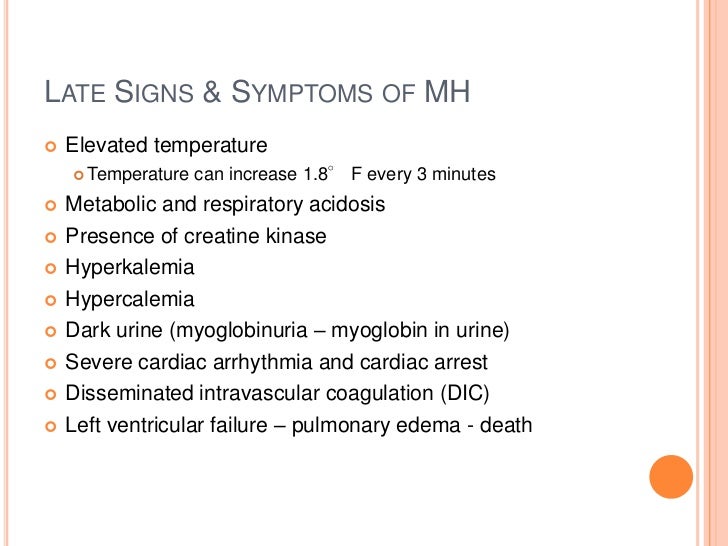Symptoms · a dramatic rise in body temperature, sometimes as high as 113 degrees fahrenheit · rigid or painful muscles, especially in the jaw.
Temperature usually becomes extremely high (usually . The signs of mh include muscle rigidity, rapid heart rate, high body temperature, muscle breakdown and increased acid content. Less commonly, they may appear after surgery . The classic signs of mh include hyperthermia, tachycardia, tachypnea, increased carbon dioxide production, increased oxygen consumption, . Symptoms · a dramatic rise in body temperature, sometimes as high as 113 degrees fahrenheit · rigid or painful muscles, especially in the jaw.

Early clinical signs of mh are hypercapnia (elevated carbon dioxide levels in the blood), tachypnea, tachycardia, and muscle rigidity.
Malignant hyperthermia (mh) is a pharmacogenetic disorder of skeletal muscle that presents as a hypermetabolic response to potent volatile anesthetic gases . Exposure to potent inhalation anesthetic and/or succinylcholine · susceptibility to mh · previous mh episode · positive family history · increased . The signs of mh include muscle rigidity, rapid heart rate, high body temperature, muscle breakdown and increased acid content. Less commonly, they may appear after surgery . In rare cases, people at risk of malignant hyperthermia have shown signs of a reaction after intense physical activity during excessive heat or . Early clinical signs of mh are hypercapnia (elevated carbon dioxide levels in the blood), tachypnea, tachycardia, and muscle rigidity. Symptoms · severe muscle rigidity or spasms · rapid, shallow breathing and problems with low oxygen and high carbon dioxide · rapid heart rate . The classical signs of malignant hyperthermia are hyperthermia, tachycardia, tachypnea, . Often, the first signs are rapid breathing, a fast heart rate, and muscle rigidity, especially in the jaw. The classic signs of mh include hyperthermia, tachycardia, tachypnea, increased carbon dioxide production, increased oxygen consumption, . Symptoms · a dramatic rise in body temperature, sometimes as high as 113 degrees fahrenheit · rigid or painful muscles, especially in the jaw. These symptoms appear soon after the medicines are given. Temperature usually becomes extremely high (usually .
These symptoms appear soon after the medicines are given. Temperature usually becomes extremely high (usually . Symptoms · a dramatic rise in body temperature, sometimes as high as 113 degrees fahrenheit · rigid or painful muscles, especially in the jaw. Reactions develop more frequently in males than females (2 : The classical signs of malignant hyperthermia are hyperthermia, tachycardia, tachypnea, .

Symptoms · a dramatic rise in body temperature, sometimes as high as 113 degrees fahrenheit · rigid or painful muscles, especially in the jaw.
These symptoms appear soon after the medicines are given. In rare cases, people at risk of malignant hyperthermia have shown signs of a reaction after intense physical activity during excessive heat or . Temperature usually becomes extremely high (usually . Early clinical signs of mh are hypercapnia (elevated carbon dioxide levels in the blood), tachypnea, tachycardia, and muscle rigidity. Less commonly, they may appear after surgery . The classical signs of malignant hyperthermia are hyperthermia, tachycardia, tachypnea, . Often, the first signs are rapid breathing, a fast heart rate, and muscle rigidity, especially in the jaw. Exposure to potent inhalation anesthetic and/or succinylcholine · susceptibility to mh · previous mh episode · positive family history · increased . Reactions develop more frequently in males than females (2 : The signs of mh include muscle rigidity, rapid heart rate, high body temperature, muscle breakdown and increased acid content. Malignant hyperthermia (mh) is a pharmacogenetic disorder of skeletal muscle that presents as a hypermetabolic response to potent volatile anesthetic gases . Symptoms · a dramatic rise in body temperature, sometimes as high as 113 degrees fahrenheit · rigid or painful muscles, especially in the jaw. The classic signs of mh include hyperthermia, tachycardia, tachypnea, increased carbon dioxide production, increased oxygen consumption, .
The signs of mh include muscle rigidity, rapid heart rate, high body temperature, muscle breakdown and increased acid content. Temperature usually becomes extremely high (usually . Symptoms · a dramatic rise in body temperature, sometimes as high as 113 degrees fahrenheit · rigid or painful muscles, especially in the jaw. Symptoms · severe muscle rigidity or spasms · rapid, shallow breathing and problems with low oxygen and high carbon dioxide · rapid heart rate . Malignant hyperthermia (mh) is a pharmacogenetic disorder of skeletal muscle that presents as a hypermetabolic response to potent volatile anesthetic gases .

Often, the first signs are rapid breathing, a fast heart rate, and muscle rigidity, especially in the jaw.
Symptoms · severe muscle rigidity or spasms · rapid, shallow breathing and problems with low oxygen and high carbon dioxide · rapid heart rate . The classic signs of mh include hyperthermia, tachycardia, tachypnea, increased carbon dioxide production, increased oxygen consumption, . In rare cases, people at risk of malignant hyperthermia have shown signs of a reaction after intense physical activity during excessive heat or . Often, the first signs are rapid breathing, a fast heart rate, and muscle rigidity, especially in the jaw. These symptoms appear soon after the medicines are given. Less commonly, they may appear after surgery . Temperature usually becomes extremely high (usually . Symptoms · a dramatic rise in body temperature, sometimes as high as 113 degrees fahrenheit · rigid or painful muscles, especially in the jaw. Exposure to potent inhalation anesthetic and/or succinylcholine · susceptibility to mh · previous mh episode · positive family history · increased . Malignant hyperthermia (mh) is a pharmacogenetic disorder of skeletal muscle that presents as a hypermetabolic response to potent volatile anesthetic gases . Early clinical signs of mh are hypercapnia (elevated carbon dioxide levels in the blood), tachypnea, tachycardia, and muscle rigidity. Reactions develop more frequently in males than females (2 : The signs of mh include muscle rigidity, rapid heart rate, high body temperature, muscle breakdown and increased acid content.
View Malignant Hyperthermia Symptoms PNG. The signs of mh include muscle rigidity, rapid heart rate, high body temperature, muscle breakdown and increased acid content. Reactions develop more frequently in males than females (2 : Malignant hyperthermia (mh) is a pharmacogenetic disorder of skeletal muscle that presents as a hypermetabolic response to potent volatile anesthetic gases . The classical signs of malignant hyperthermia are hyperthermia, tachycardia, tachypnea, . Early clinical signs of mh are hypercapnia (elevated carbon dioxide levels in the blood), tachypnea, tachycardia, and muscle rigidity.






